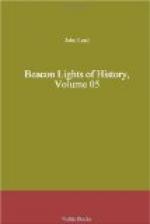and hardship. No aristocratic tears are shed for
them; they are no better than dogs or cattle.
The mother is heartbroken. Not one of her children
can ordinarily rise from their abject position; they
can live and breathe the common air, and that is all.
They are unmolested in their mud huts, if they will
toil for the owner of their village at the foot of
the baronial castle. But one of her sons is bright
and religious. He attracts the attention of a
sympathetic monk, whose venerable retreat is shaded
with trees, adorned with flowers, and seated perhaps
on the side of a murmuring stream, whose banks have
been made fertile by industry and beautiful with herds
of cattle and flocks of sheep. He urges the afflicted
mother to consecrate him to the service of the Church;
and the boy enters the sanctuary and is educated according
to the fashion of the age, growing up a sad, melancholy,
austere, and pharisaical member of the fraternity,
whose spirit is buried in a gloomy grave of ascetic
severities, He passes from office to office. In
time he becomes the prior of his convent,—possibly
its abbot, the equal of that proud baron in whose
service his father lost his life, the controller of
innumerable acres, the minister of kings. How,
outside the Church, could he thus have arisen?
But in the monastery he is enabled, in the most aristocratic
age of the world, to rise to the highest of worldly
dignities. And he is a man of peace and not of
war. He hates war; he seeks to quell dissensions
and quarrels. He believes that there is a higher
than the warrior’s excellence. Monachism
recognized what feudalism did not,—the
claims of man as man. In this respect it was
human and sympathetic. It furnished a retreat
from misery and oppression. It favored contemplative
habits and the passive virtues, so much needed in
turbulent times. Whatever faults the monks had,
it must be allowed that they alleviated sufferings,
and presented the only consolation that their gloomy
and iron age afforded. In an imperfect manner
their convents answered the purpose of our modern hotels,
hospitals, and schools. It was benevolence, charity,
and piety which the monks aimed to secure, and which
they often succeeded in diffusing among people more
wretched and ignorant than themselves.
AUTHORITIES.
Saint Bernard’s Works, especially the Epistles;
Mabillon; Helyot’s
Histoire des Ordres Monastiques; Dugdale’s Monasticon;
Doering’s
Geschichte der Monchsorden; Montalembert’s Les
Moines d’Occident;
Milman’s Latin Christianity; Morison’s
Life and Times of Saint Bernard;
Lives of the English Saints; Stephen Harding; Histoire
d’Abbaye de
Cluny, par M.P. Lorain; Neander’s Church
History; Butler’s Lives of the
Saints; Vaughan’s Life of Thomas Aquinas; Digby’s
Ages of Faith.
SAINT ANSELM.
* * * * *
A. D. 1033-1109.
MEDIAEVAL THEOLOGY.




